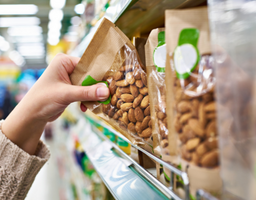
The image accompanying this blog post provides a glimpse into my work environment, showcasing the contents of my office bookshelf. While it might look to some as “trash,” each package and material on that shelf has taught me something.
A year ago, I embarked on a journey with CIFT to explore and fully embrace the possibilities of sustainable packaging within the realm of food processing. This topic is huge, and encompasses various aspects, such as materials, packaging equipment, product protection, food loss/waste, and the overall customer experience. The following four takeaways surface almost every day as I travel down this path of enhancing food packaging.
No one sets out to be wasteful.
Consumers want to buy safe, intact products, while manufacturers aim to sell safe, intact products. Dedicated packaging engineers are actively seeking the best methods to deliver these products. Packaging that uses fewer materials and minimizes food waste is not only environmentally beneficial but will benefit the bottom line. Most packaging applications have sound reasoning behind them, even if this reasoning isn’t immediately apparent to the consumer.
Technological advancements are driving improvements in design and materials. Some manufacturers may embrace these changes early on, while others might continue to use existing equipment and processes for a bit longer. The focus lies in creating thinner, lighter packages and eliminating unnecessary or problematic materials. It’s also important to recognize that some packaging practices are rooted in tradition (“it’s always been that way”), and these should be reevaluated. Consider this the next time you encounter a plastic film window on a package. Is it truly necessary to see the product? This window adds both cost and complexity to the packaging.
Source reduction needs to be everyone’s first step.
You are familiar with the 3 R’s – Reduce, Reuse, Recycle. And they are in that order as source reduction should always take the lead. Recycling gets a lot of attention in packaging, but reducing material use through thoughtful design and efficient production will make the most impact in the life span of a package.
It is the hope that materials can be designed, collected and processed to circulate back into new and possibly different products, but the conservation and efficient use of resources is Step One.
(It’s worth noting that there are actually more than just 3 R’s. You might want to Rethink when grabbing a produce bag for instance, and Refuse yet another single-use item.)
We can’t pit one material against another.
There are applications where paper, plastic, glass and/or metal are the preferred and best choice to deliver safe and intact products. The messaging can often spark a battle between materials. Paper and boxes come from renewable sources! Plastic is lightweight! Glass in an inert material! Metal has a long history of being reclaimed! There are going to be shifts in design, but hopefully each new application does not create more harm to the environment than what it replaced. This is precisely where the convergence of science, policy, and infrastructure support for material recovery should take the lead.
Plastic is amazing, and problematic.
Without a doubt, plastic has played a vital role in saving lives (think of single-use medical supplies). The lightweight nature of plastic has conserved fuel when transporting products worldwide and has safeguarded food items, ensuring their consumption by humans (which is the ultimate goal!). But yes, it causes a waste headache that the oceans and lands will be healing from for a very, very long time.
But, remember that lesson from above? I’d say let’s find the best use of plastic, the applications that make the most sense. Let’s move more packaging to reusable and refillable and let’s exhaust solutions with fully recyclable plastic. Then let’s collect it. Other solutions like advanced (often called chemical) recycling will have a role too.
My mantra as of late has been that recycling does work, it is collection that is the weak link. We can’t wait for perfection, but we need to get better, and quick. Our collection system wasn’t designed to fully embrace all the plastics coming at it, but plastic recycling is maturing.
Improvements are coming. All the time.
It has been encouraging to learn about all the efforts being made in materials science around packaging. I would ask you to take some time to really look at each and every package that you encounter. Let a company know what you like, don’t like. Look for those “how to recycle” instructions so you don’t add burdens to the collected material stream. Oh, and start using the film recycling store drop off centers found at nearly every large retailer across the US (18,000 of those bins are out there!) How those came about could fill another blog post.



